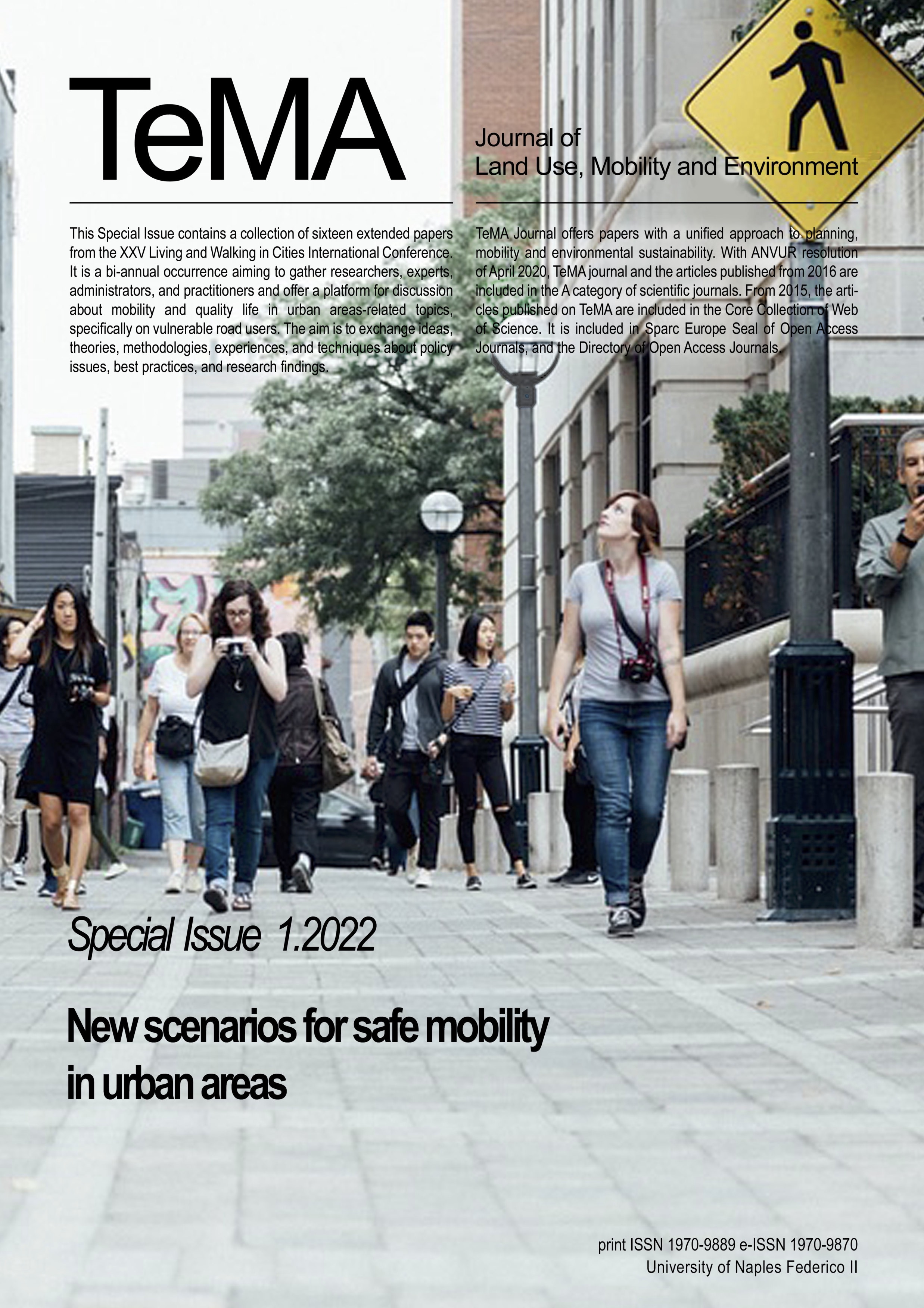The cycle network: a latent environmental infrastructure
Managing urban flooding in the region of Abruzzo
Abstract
The topic to be investigated is the potential interdependence between the cycling network and the management of rainwater in the mid-Adriatic region of Abruzzo. Preliminarily, two observations. The first concerns cycling: in Italy it is constantly increasing, both in terms of territorial diffusion and turnover. The second: the frequency of urban flooding, resulting from extreme atmospheric phenomena, has been constantly increasing. However, cycling and urban flooding are two issues addressed separately. The first is framed as a contribution to slow mobility. The second is treated as a continuing emergency. The goal is to overcome separateness. And imagine the cycle network as an environmental infrastructure that, in addition to supporting the transit of bicycles, can contribute to a better collection and management of rainwater too, as an alternative to the sewer system. This hypothesis works on those cities that have transformed water from an agent that generates dangerous conditions, into a strategic resource. Methodologically, the projects and intervention programs will be compared to the: network space, space associated with the network and context space. The comparison aims to provide some lines of action useful for orienting the actions of the urban plan in the mid-Adriatic region of Abruzzo of Abruzzo.
Downloads
References
AA.VV., (2019). Bike economy 24. L’industria, la mobilità, le opportunità. Milan: Il Sole 24 Ore.
Andersson S. L. (2019), Hans Tavsens Park, Retrieved from: https://www.sla.dk/cases/hans-tavsens-park-and-korsgade/
Bergen Jensen, M. (2015). Climate Resilient Cities. Retrieved from: https://www.youtube.com/watch?v=OOd4vOKPzEg
Bianchetti, C. (2003). Abitare la città contemporanea. Milan: Skira. 48.
Bionic Team, (2018). Elevate San Rafael. Resilient by design. Bay area challenge. Retrieved from: http://www.resilientbayarea.org/elevate-san-rafael
Boston Green Ribbon Commission (2016). Climate Ready Boston. Boston. Retrieved from: https://www.boston.gov/sites/default/files/file/2019/12/02_20161206_executivesummary_digital.pdf
Calderón, E.J. (2012). Progettare l’accessibilità attraverso i piani dei trasporti a Madrid. In: Castrignanò M., Colleoni M. & Pronello C. (Eds.). Muoversi in città. Accessibilità e mobilità nella metropoli contemporanea. Milan: Franco Angeli. 175-187.
City of Copenhagen (2011). Copenhagen Climate Adaptation Plan. Retrieved from: https://international.kk.dk/artikel/climate-adaptation
City of Copenhagen (2012). Cloudburst Management Plan. Retrieved from: https://en.klimatilpasning.dk/media/665626/cph_-_cloudburst_management_plan.pdf
City of Melbourne (2012 a). Bicycle plan 2012–16. Retrieved from: https://www.melbourne.vic.gov.au/SiteCollectionDocuments/bicycle-plan-2012-2016.pdf
City of Melbourne (2012 b). Urban Forest Strategy. Making a great city greener 2012-2032. Retrieved from: https://www.melbourne.vic.gov.au/SiteCollectionDocuments/urban-forest-strategy.pdf
City of Melbourne (2013). La Trobe Street green bicycle lane. Retrieved from: http://urbanwater.melbourne.vic.gov.au/
City of Melbourne (2014). Total watermark-City as a catchment. Retrieved from: https://www.clearwatervic.com.au/user-data/resource-files/City-of-Melbourne-Total-Watermark-Strategy.pdf
City of Philadelphia (2016). Green Streets Design Manual. Design standards and guidance for developers building green stormwater infrastructure. Retrieved from: https://www.phila.gov/documents/green-streets-design-manual/
Colville-Andersen, M. (2015). The Copenhagenize Current - Stormwater Management and Cycle Tracks. Retrieved from: http://www.copenhagenize.com/2015/03/the-copenhagenize-current-stormwater.html
Colville-Andersen, M. (2018). Copenaghenize. The definitive guide to global bicycle urbanisme. Washington: Island press. 275.
Comuni Ciclabili FIAB (2021). Guida ai comuni ciclabili d’Italia. Rome. Retrieved from: http://www.comuniciclabili.it/4-edizione-2021/
Confartigianato Ufficio Studi (2020). 5° Rapporto Artibici. Artigianato e filiera della bicicletta, Rome. Retrieved from: https://www.confartigianato.it/wp-content/uploads/2020/10/Confartigianato_Artibici2020_v11_08102020_web.pdf
Deromedis, S. (2019). Il manuale delle piste ciclabili e della ciclabilità. Venezia: Ediciclo.
ECF (2016) European Cyclists’ Federation. The EU Cycling Economy. Argument for an integrated EU cycling policy. Brussels. Retrieved from: https://ecf.com/sites/ecf.com/files/FINAL%20THE%20EU%20CYCLING%20ECONOMY_low%20res.pdf
Fleury, D. (2012). Sicurezza e urbanistica. L’integrazione della sicurezza stradale nel governo urbano. Rome: Gangemi. 190-193.
Giuliani F. & Maternini G. (Eds.) (2018). Mobilità ciclistica. Metodi, politiche e tecniche. Forlì: Egaf.
Haffner J. (Eds.) (2015), Developing resilience. Living with water strategies for Greater Boston. Boston: Urban Land Institute. 7. Retrieved from: https://ulidigitalmarketing.blob.core.windows.net/ulidcnc/2012/04/ULI-Developing-Resilience-Report-FINAL.pdf
ISFORT (2020) Istituto Superiore di Formazione e Ricerca per i Trasporti. 17° Rapporto sulla mobilità degli italiani. Rome. Retrieved from: https://www.isfort.it/progetti/17-rapporto-audimob-sulla-mobilita-degli-italiani/
ISPRA (2020) Istituto Superiore per la Protezione e la Ricerca Ambientale. XV Rapporto Qualità dell’ambiente urbano. Suolo e territorio. Rome. Retrieved from: https://www.snpambiente.it/wp-content/uploads/2020/09/Cap.-2.pdf
Legambiente (2020), Rapporto 2020 dell’osservatorio di Legambiente Cittàclima. Il clima è già cambiato. Rome. 72. Retrieved from: https://cittaclima.it/wp-content/uploads/2020/11/CC_Rapporto_2020-def.pdf
Parkin, J. (Eds.) (2012). Cycling and Sustainability. Bingley: Emerald Publishing.
Philadelphia Water Department (2011-2021). Green City-Clean Water. Philadelphia. Retrieved from: https://water.phila.gov/green-city/
PlasticRoad (2018). Smart sustainable infra solutions. Circular climate-adaptive lightweight. Retrieved from: https://www.plasticroad.eu/en/
Ramboll, (2013). Cloudburst Concretisation Masterplan. Retrieved from: https://ramboll.com/projects/group/copenhagen-cloudburst
Salvati P. & Bianchi C. (2019). Rapporto sul Rischio posto alla Popolazione italiana da Frane e Inondazioni. Quinquennio 2014-2018. Perugia. Retrieved from: https://polaris.irpi.cnr.it/wp-content/uploads/POLARIS-Rapporto-quinquennale-2014-2018.pdf
Slaney, S. (Eds.) (2016). Stormwater Management for Sustainable Urban Environments. Melbourne: The Images Publishing.
Tira M. & Zazzi M. (2007). Pianificare le reti ciclabili territoriali. Rome: Gangemi.
Tredje Natur, 2016. The first climate district. URL: https://www.tredjenatur.dk/en/portfolio/the-first-climate-district/
Vittadini, M.R. (2015). Non solo trasporti: politiche urbane per una nuova mobilità. In: Donati A. & Petracchini F. (Eds.). Muoversi in città. Esperienze e idee per la mobilità nuova in Italia. Milan: Edizioni Ambiente. 275-286.
Wright, M. (Eds.) (2015). Rainwater Park: Stormwater Management and Utilization in Landscape Design. Melbourne: The Images Publishing.
Copyright (c) 2022 TeMA - Journal of Land Use, Mobility and Environment

This work is licensed under a Creative Commons Attribution 4.0 International License.
Authors who publish in this journal agree to the following:
1. Authors retain the rights to their work and give in to the journal the right of first publication of the work simultaneously licensed under a Creative Commons License - Attribution that allows others to share the work indicating the authorship and the initial publication in this journal.
2. Authors can adhere to other agreements of non-exclusive license for the distribution of the published version of the work (ex. To deposit it in an institutional repository or to publish it in a monography), provided to indicate that the document was first published in this journal.
3. Authors can distribute their work online (ex. In institutional repositories or in their website) prior to and during the submission process, as it can lead to productive exchanges and it can increase the quotations of the published work (See The Effect of Open Access)

